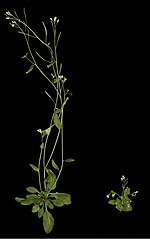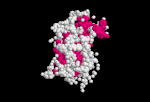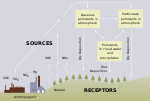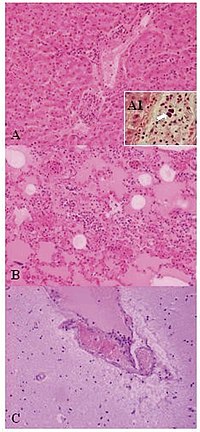Acid growth refers to the ability of plant cells and plant cell walls to elongate or expand quickly at low (acidic) pH. The cell wall needs to be modified...
2 KB (294 words) - 18:16, 20 August 2023
The acid-growth hypothesis is a theory that explains the expansion dynamics of cells and organs in plants. It was originally proposed by Achim Hager and...
14 KB (1,787 words) - 02:49, 11 January 2024
Plant hormone (redirect from Plant growth substance)
bona fide hormones is still debated. Abscisic acid (also called ABA) is one of the most important plant growth inhibitors. It was discovered and researched...
56 KB (7,035 words) - 15:39, 17 May 2024
that when indole-3-acetic acid (IAA), a naturally-occurring auxin, was used at high concentrations, it could stop plant growth. In 1940, he published his...
44 KB (4,800 words) - 12:12, 14 July 2024
(polyaspartic acid), low calorie sweeteners (aspartame), scale and corrosion inhibitors, and resins.[citation needed] One area of aspartic acid market growth is...
20 KB (1,867 words) - 17:14, 8 July 2024
preventing pores from clogging up, and allowing room for new cell growth. Salicylic acid inhibits the oxidation of uridine-5-diphosphoglucose (UDPG) competitively...
38 KB (3,451 words) - 09:23, 8 July 2024
Pantothenic acid (vitamin B5) is a B vitamin and an essential nutrient. All animals need pantothenic acid in order to synthesize coenzyme A (CoA), which...
32 KB (3,266 words) - 02:34, 11 July 2024
stimulates production of insulin-like growth factor 1 (IGF-1) and increases the concentration of glucose and free fatty acids. It is a type of mitogen which...
57 KB (6,664 words) - 15:04, 22 July 2024
contain the minimum nutrients possible for colony growth, generally without the presence of amino acids, and are often used by microbiologists and geneticists...
21 KB (2,206 words) - 08:28, 22 February 2024
magnesium which play a role in plant growth and maintaining healthy soil. In terms of human infrastructure, acid rain also causes paint to peel, corrosion...
85 KB (9,411 words) - 06:34, 13 July 2024
industrially using microorganisms. Gibberellic acid is a simple gibberellin, a pentacyclic diterpene acid promoting growth and elongation of cells. It affects decomposition...
7 KB (629 words) - 08:33, 19 July 2024
growth and proliferation and cytotoxic T lymphocyte activity. Lastly, BCAAs share the same transport protein into the brain with aromatic amino acids...
29 KB (3,420 words) - 14:14, 26 May 2024
Humic substance (redirect from Fulvic acid)
umbrella term covering humic acid, fulvic acid, humin, and hymatomelanic acid, which differ in solubility. By definition, humic acid is soluble in water at...
34 KB (4,275 words) - 08:39, 20 July 2024
GABA (redirect from Gamma aminobutyric acid)
GABA (γ-Aminobutyric acid) is the chief inhibitory neurotransmitter in the developmentally mature mammalian central nervous system. Its principal role...
51 KB (5,557 words) - 10:16, 12 July 2024
mediates the functions of vitamin A1 required for growth and development. All-trans-retinoic acid is required in chordate animals, which includes all...
14 KB (1,538 words) - 08:23, 26 March 2024
plant growth and protection in sustainable agriculture is underway. Skatole, the odorant in feces, is produced from tryptophan via indoleacetic acid. Decarboxylation...
26 KB (2,766 words) - 00:37, 15 May 2024
an electron pair, known as a Lewis acid. The first category of acids are the proton donors, or Brønsted–Lowry acids. In the special case of aqueous solutions...
47 KB (5,956 words) - 18:26, 8 July 2024
organic acids. A few common examples include: Lactic acid Acetic acid Formic acid Citric acid Oxalic acid Uric acid Malic acid Tartaric acid Butyric acid Folic...
10 KB (1,203 words) - 08:21, 1 July 2024
bacteria (LAB). Production of lactic acid has linked LAB with food fermentations, as acidification inhibits the growth of spoilage agents. Proteinaceous...
28 KB (2,800 words) - 04:59, 16 July 2024
"Indole-3-butyric acid in plant growth and development". Plant Growth Regulation. Vol. 32, no. 2–3. Media related to Indolebutyric acid at Wikimedia Commons...
7 KB (678 words) - 23:22, 13 April 2024
Sermorelin (category Growth hormone secretagogues)
hormone (GH) secretion for the purpose of diagnosing growth hormone deficiency. It is a 29-amino acid polypeptide representing the 1–29 fragment from endogenous...
6 KB (135 words) - 13:44, 23 January 2024
leaves undergo rapid acid growth, which is an expansion of individual cells as opposed to cell division. The rapid acid growth allows the sundews' tentacles...
102 KB (11,885 words) - 17:17, 29 June 2024
Formic acid (from Latin formica 'ant'), systematically named methanoic acid, is the simplest carboxylic acid, and has the chemical formula HCOOH and structure...
38 KB (3,910 words) - 23:31, 9 July 2024
Auxin (category Plant growth regulators)
especially 1-naphthaleneacetic acid (NAA) and indole-3-butyric acid (IBA), are also commonly applied to stimulate root growth when taking cuttings of plants...
45 KB (5,180 words) - 13:12, 15 June 2024
carotenoids, plant acids (e.g. butyric acid, citric acid, formic acid, gallic acid, malic acid, propionic acid), resin, tannins and ascorbic acid (vitamin C)...
52 KB (5,624 words) - 20:37, 27 April 2024
Hyaluronic acid (/ˌhaɪ.əljʊəˈrɒnɪk/; abbreviated HA; conjugate base hyaluronate), also called hyaluronan, is an anionic, nonsulfated glycosaminoglycan...
50 KB (5,491 words) - 13:36, 29 June 2024
rest period and the occurrence of an acidic ether soluble growth inhibitor in potato tubers. In 1963, abscisic acid was first identified and characterized...
25 KB (2,635 words) - 20:05, 6 July 2024
differentiation by binding to its receptor, EGFR. Human EGF is 6-kDa and has 53 amino acid residues and three intramolecular disulfide bonds. EGF was originally described...
17 KB (1,708 words) - 13:56, 21 July 2024
Taurine (redirect from 2-aminoethanesulfonic acid)
Taurine (/ˈtɔːriːn/), or 2-aminoethanesulfonic acid, is a non-proteinogenic naturally occurred amino sulfonic acid that is widely distributed in animal tissues...
28 KB (2,903 words) - 13:45, 20 June 2024
Amino acids are organic compounds that contain both amino and carboxylic acid functional groups. Although over 500 amino acids exist in nature, by far...
97 KB (10,074 words) - 18:14, 1 July 2024


























